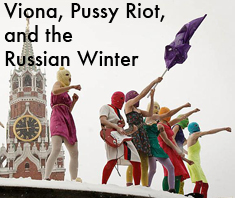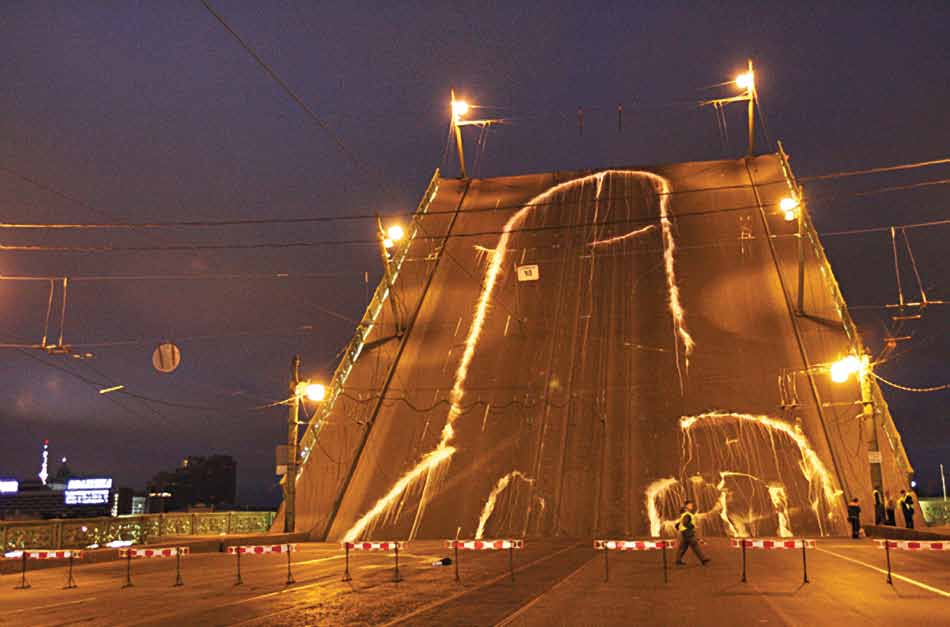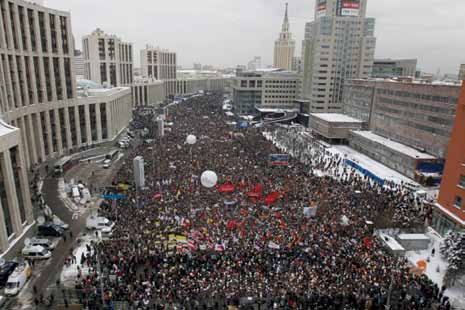Written By: Nadia Khismatulina
Published in Print in Issue 10 of SFAQ
The political fever running across the world has occupied the headlines of all possible periodicals since the advent of the “Arab Spring” in the Middle East. But perhaps less recognized in the United States, was the net of massive protests “For Fair Elections” that spread across Russia during the parliamentary elections of December 4th, 2011, and presidential elections of March 4th, 2012 – a period of time that quickly became referred to as the “Russian Winter.” Perhaps unexpectedly, SFAQ’s recent attention to the clash of art and politics has made it a relevant publication to explore these international issues.

Pussy Riot, “Punk-Prayer” spontaneously and illegally performed by the group at the ambo of the Christ the Savior Cathedral in Moscow on February 21, 2012. Photograhy courtesy of REUTERS/Maxim Shemetov.
What is urgent for Russia today – is not necessarily the reorganization of our political system. Not much can be done in that direction – as these last elections confirmed. Numerous demonstrations against their abuse of power only provoked a new amendment, appointing proportionately enormous fines for unsanctioned public gatherings and rallies. The waves of civic violation reports from the parliamentary and presidential elections continue to stand unattended. But surprisingly, what is really in the air after the Russian fall and winter of 2011, is the emergence of a “creative class” and its positioning upon the political and cultural stage. Quite suitably this subject has developed in response to the creative public practices of several radical art groups.
Extensively covered by the international media was an early call from the summer of 2010 by the Saint-Petersburg based art group Voina. Known for their brave and extravagant performances, Voina spurred the tension with a series of brassy political actions. “The War” (as their name indeed means) started long ago with “Fuck For The Bear” – a public orgy performance in the Moscow Biology Museum. Devoted to the 2008 presidential elections and predicting the appointment of Vladimir Medvedev—whose name in Russian loosely translates to “Mr. Bears” – “Fuck For The Bear” is among Voina’s most recognized performances.

February 29th, 2008, Voina staged a live public orgy at the State Museum of Biology in the hall “Metabolism, energy, nutrition, digestion”. While five couples were copulating, the Voina chief media artist Alexei Plutser-Sarno, wearing a tuxedo and a top-hat, was holding a black preelectoral banner reading “Fuck for the heir-bear”.
But in June of 2010, they made an even bigger splash in the public sphere with the enormous penis painted onto one of Saint-Petersburg’s signature draw-bridges. During the rise and fall of its crossing, the 210-foot phallus became erect, rising to attention while facing the headquarters of the FSB (formerly KGB); the legendary building at the 4 Litejny Prospect that is unofficially nicknamed “The Big House.” Here, starting as early as the 1930’s, the national security services have resided, evolving from NKVD to KGB to FSB today. The long-feared institution was undoubtedly an inspiration for “Dick Captured By The FSB”, as Voina entitled the action. After a month’s worth of preparation, the scandalous drawing was implemented within twenty-three seconds and lasted for only one night before being removed by authorities. Although short-lived, under such charged conditions it was obviously a fantastic success.
Encouraged by the public resonance they managed to evoke with Dick Captured By The FSB, Voina moved on to one of their most “violent” performances: “Palace Coup”, held in November 2010. During the performance, Voina members and their associates protesting against the Russian police state overturned police cars, sometimes with the officers still inside. Apparently this was the “last straw” for the Russian authorities and members of the group, while previously clashing with the police on a number of occasions, were finally arrested. Two members were jailed for three months and threatened with long-term sentences of up to seven years. Charged with the damage of state property, Voina’s actions were denied the status of art practice and were framed in terms of vandalism, which raises many thought-provoking questions.
Voina aficionado and prominent Russian art historian Andrey Yerofeyev noted that there are a number of professions that assume a certain vandalism and trespassing of private property in the execution of their work—such as fire-fighters, security guards, forest guards, surgeons, etc. But the actions of these professionals aren’t questioned, as they are directed towards the general public good. Similarly, according to Yerofeyev, artists and Voina specifically “commit blameworthy acts not for fun and not out of naughtiness, but out of a desire to normalize the relationship between an individual and authority.” [1]
Compared to the generosity of this noble service, what are a couple of broken police flashers and a stained bridge? Referencing Voina’s Dick, Yerofeyev proclaimed that “society has the right for the asymmetrical response in a form of graffiti, when all the legitimate methods of contestation are exhausted… Art-group Voina reacts on the rejection of the verbal dialog: on the impudent gesture of the authorities, they respond with the obscene gesture.” [2]
The Voina heroes were eventually released, unlike members of another radical art-group, the punk and feminist Pussy Riot. Three activists of Pussy Riot were jailed after the audacious action: “Punk-Prayer”, spontaneously and illegally performed by the group at the ambo of the Christ the Savior Cathedral in Moscow on February 21, 2012.
Wearing saturated dresses, tights and masks, ladies sang an alternative prayer in the spirit of “the patriarch, Gounday, believes in Putin, he’d better believe in God, bitch,” accompanied by electric guitar.
This extreme expression of dissent was directed against the amalgamation of Russian Orthodox Church and governmental power institutions; which come with inevitable consequences for contemporary Russian secular and political life, as well as against the otherwise unexplainable superior position of “Pravoslavie.” Two of them young mothers, the activists have been imprisoned ever since, facing seven-year sentences for their art action.
Both of these instances of artists jailed for their extreme, though justified, actions have been exceptionally resonant in local and international media accounts. Cases of outstanding civic courage or artistic audacity, and their rampageous reaction and severe censorship by authorities, have caught the world’s attention. But rare attention has been paid to an audience’s response – the field where the real politics happen.
The artworks marked the pre-election agony of a Russian society panicking to receive Putin yet again as the newly-minted president of the Federation; while still no solid alternative had risen to prominence. Both Voina’s attacks on the police and Pussy Riot’s appeal to congregation captured the sensibility of distrust in regard to the power structures stemming from Putin’s administration.
At the same time, the public reception of these provocations held a similar dichotomy that revealed itself during the winter protests: between those who associated the Putin government with reactionary regime and those for whom it provided a period of relatively calm economic and political climate.
Due to this grievous rift in the societal fabric, many were shocked when Voina’s “Dick Captured By The FSB” was named “the best work of art in 2010” and awarded the National Innovation Award: Russia’s only contemporary visual arts honor. Since the award has an independent status, but was established and supported by the National Center for Contemporary Arts, its ceremony turned into a revolution of sorts. While officially, Innovation has no direct relation to Russian cultural politics, the decisions and precedents produced by its jury are interpreted by professional communities and general audiences as a measure of the state’s loyalty to contemporary culture. Therefore, the fact that Voina’s art intervention was acknowledged as the most significant work of the year, was a gesture of cultural legitimization and recognition of the artwork’s aesthetic and relevance, if not political validity.
Still, this has in no way resolved its controversy; on the contrary, this created an absurdly schizophrenic situation. While one administrative resource is censoring Voina’s activity, another celebrates it as a prominent work of art. The event caused resentment not limited to the enfranchised, but across broad segments of Russia’s general public. One of the few protests was organized by the Young Russia movement in front of the Ministry of Culture building in Moscow, proclaiming it “the most fucked ministry” for rewarding the vandals with a prize. The discussions around “how to live in the country where ‘Dick Captured By The FSB’ is called art” also spread across the nation.
Even today, cultural and intellectual elites have no consensus on the role and significance of Voina in the general development of oppositional consciousness that was demonstrated by Russian society throughout the fall and winter. Just as they also maintain dissonant perspectives on Pussy Riot’s imprisonment or release.
The “Punk-Prayer” spurred a far more negative and cohesive reaction. Religious matters in the post-Soviet Russia appeared to be a sensitive, truly sacred ground, something Pussy Riot definitely counted on.
“Antipussings” – the protests against the group encouraging a preservation of moral purity occurred in several cities across the country. The Church itself forwarded requests to the government to punish offenders of the faithful. Professionals went on critical discussions, questioning how punk and feminist the group really is, then dissecting their inspirations and vocal merits. But when it became a public realization that the seven-year sentence, only a threat for Voina, was a reality for the three young women that illegally performed a scandalous song – even arrant Christians felt the disproportion.
Harsher in this case, justice would not be satisfied by administrative charge. On June 12, 2012 the indictment was published, where in addition to accusations of “blasphemous humiliation of age-old foundations of the Russian Orthodox Church”, the prosecution called the group’s “colorful” outfits “defiantly bright”, and bombastically accused them of “jumping, lifting up legs, imitating dance and punching” which contributed to the severe public disorder they caused. The indictment was confirmed and accepted by the court. As quickly as the following day, this announcement was skewered by an anonymous performance, with a female figure in the Pussy Riot outfit crucified in front of the ill-fated cathedral. The inscription on the cross read: “here might be your democracy”.
It is necessary now to remind that the public debates, addresses and petitions enflamed by these radical art-groups were not only concurrent with the general atmosphere of political unrest and unusual public socio-political activity in Russia. They were also organically if not causally related one to another. The extreme character of Voina and Pussy Riot practices and their pretense to frame those practices in terms of art in a rather conservative (aesthetically too) Russian society was appreciated only by few and appeared unclaimed by the general public. Needless to say, these groups were not recognized as flagships of the Protest. Nevertheless, while winter “For-Fair-Elections” demonstrators were exploring the limits of their personal aesthetic tolerance towards the performances, the authorities made quite a direct connection between the two.
To the official media, the masses protesting on the streets and on the Internet were frequently identified as the “creative class”. Rightful in a sense, since among the protesters were indeed many now known as creative professionals, who used to be known in Russia as the “intelligencia” – writers, actors, artists, publishers, photographers, reporters, etc. – this denomination seems to me far more strategic. Making an effective relation between the concurrent questionable art activities and unpredictable political and economic results of the opposition movement, the “creative class” became a sort of rhetoric weapon leveling both. This latent “Dick is your new face” message happened to be challenging and even polarizing; not necessarily for the demonstrators themselves, although there is a range of attitudes towards Voina and Pussy Riot, but for the majority of those who are now making their political choices far away from the epicenters of protest and aesthetic avant-gardes. For them “creative class” is now perhaps associated with the “elitist” and often difficult to accept extravagancy of these art actions. Something which is not always forgivable in matters of art, and much less so in lifelong decisions – what “election” in Russia has come to mean.
At the same time, for progressive minded public personas, that are aware of the neoliberal contexts and political limitation related to “creative class” as it is understood globally, association with one means the abortion of the forwardist opposition project. For instance, Ekaterina Degot, an internationally recognized art historian, curator and critic, who was among the Innovation jury members that bestowed the prize to Voina, openly expresses her idiosyncrasies regarding the Russian creative class. “Degot recently wrote a column for the website she edits, OpenSpace.ru, that was filled with disgust at the ‘creative class’ – designers, copywriters, managers and PR people who consume contemporary art as a form of high-class, fashionable entertainment.” [3] This way, the identification of the protesters with radical contemporary art practices through the instrumentalized concept of “creative class” rather than being a sociological finding, becomes that ideological divide that leaves nascent opposition without electorate.
However, this situation when creative class becomes a mediator, and sometimes a false one, between the politically uncertain yet formally expressive public resistance and its contemporary art representations, is not uncommon. A much different, but curious case is unwinding right now in dear to me San Francisco with the current “Occupy” exhibition at Yerba Buena [YBCA]. As one might guess, this show is based on the paraphernalia and spirit of the famed Occupy movement. Yet the process turned out to be far less representational: according to some Occupy activists, they have not been invited for any kind of collaboration at any stage of the show’s development, neither did they get any financial support that the show might have generated. This detail once again provokes a reflection on the fair line between contemporary politically conscious art and real political work, the line that nevertheless is sometimes so hard to cross.
[1] The full text of his article “How to Judge Voina?” in Russian can be found at http://artchronika.ru/
gorod/как-судить-«войну». Translation Nadia Khismatulina
[2]Ibid.
[3]From a review on her recent exhibition devoted to contemporary art production by Valentin
Diaconov: http://blog.frieze.com/1st-ural-industrial-biennal/





